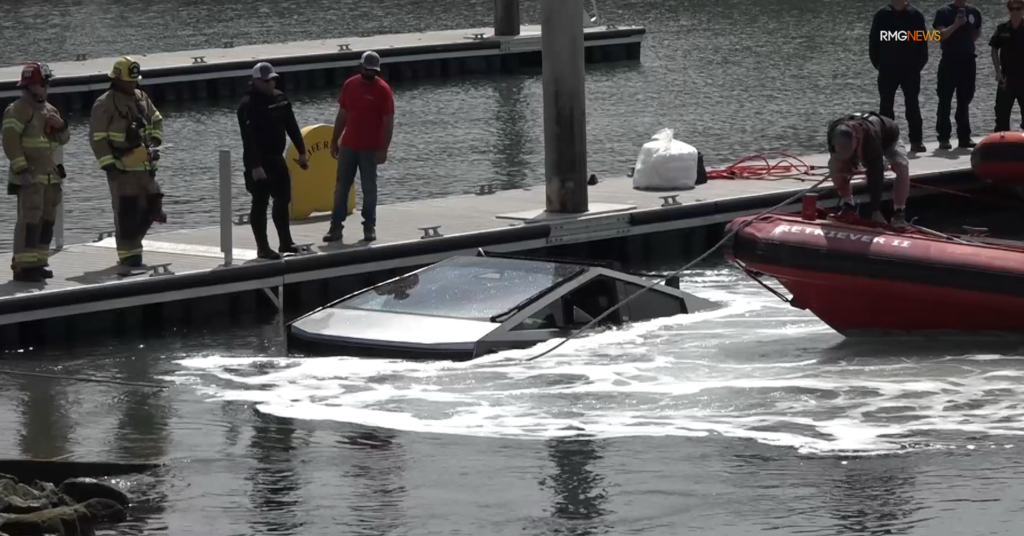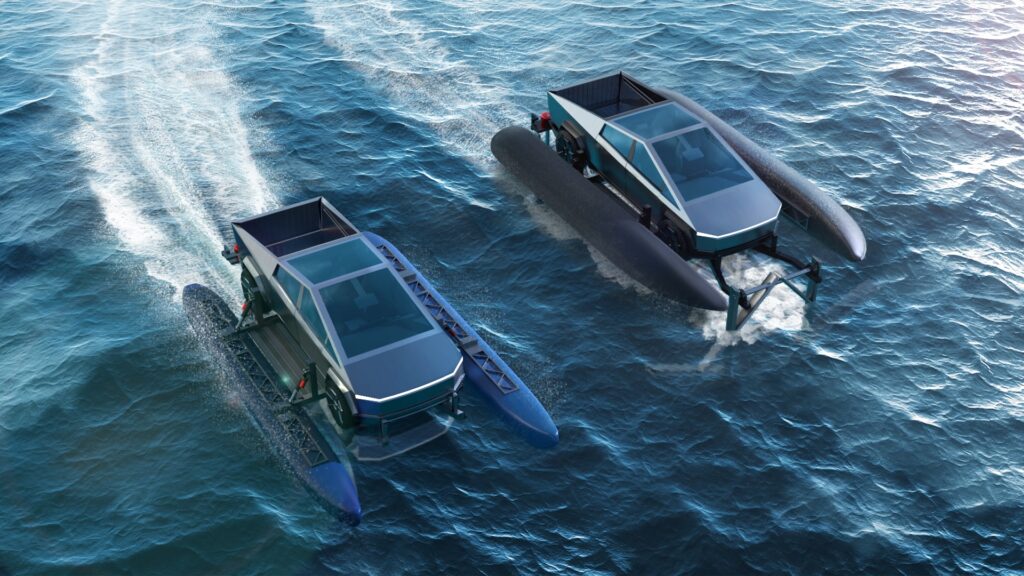
Introduction
In a scene that could’ve been ripped from a slapstick comedy, a stainless-steel Tesla Cybertruck—hailed as the future of electric vehicles—met an ironic fate on March 10, 2025. Instead of cruising down a highway, it sank like a stone in Ventura Harbor, California, after a disastrous jet ski launch attempt. The owner, aiming to back his prized EV down the boat ramp, accidentally shifted into reverse, sending the angular truck sliding backward into the water. Within minutes, the $100,000+ vehicle vanished beneath the waves, leaving bystanders stunned and social media buzzing.
The incident didn’t just embarrass the driver—it reignited a fiery debate about Elon Musk’s bold 2022 claim that the Tesla Cybertruck could double as a makeshift boat. “It’s waterproof enough to serve briefly as a boat,” Musk had declared, suggesting it could even cross rivers or short stretches of ocean. But as Ventura’s harbor fire crews hoisted the soggy Tesla Cybertruck onto dry land, one thing became clear: this EV is no Titanic (and we mean that literally).
This article dives into how a simple mistake at a California boat ramp turned into a viral cautionary tale. We’ll unpack the rescue mission, analyze Musk’s controversial claims, and explore what this mishap means for EV owners. Was this a case of user error, a design flaw, or proof that even cutting-edge tech can’t outwit gravity? Let’s find out.
Tesla Cybertruck Submerged in Ventura Harbor: What Happened?

On March 10, 2025, a Tesla Cybertruck made headlines for an unexpected reason: it sank in Ventura Harbor, California. The incident occurred when the owner, attempting to launch a jet ski, accidentally shifted the electric truck into reverse instead of drive. Within moments, the vehicle slid backward down the boat ramp and plunged into the water, disappearing under 8 feet of saltwater.
Eyewitnesses described the Tesla Cybertruck “bobbing” briefly before sinking, as reported by ABC7 Los Angeles. Emergency crews, including the Ventura City Fire Department and TowBoatUS Ventura, swiftly responded. A diver secured cables to the submerged truck, which was entangled under a dock. The recovery mission took less than two hours, but the viral footage of water gushing out of the vehicle’s windows sparked global debate.
Why the Cybertruck Sank: User Error or Design Flaw?
While the driver admitted fault, the incident reignited questions about Elon Musk’s 2022 claim that the Cybertruck could “serve briefly as a boat.” Musk had even suggested it could traverse rivers or the 360-meter channel between SpaceX’s Starbase and South Padre Island. Yet, the Ventura Harbor incident proved the stainless-steel EV isn’t buoyant.
“Electric vehicles have unique risks in water,” said Captain Carson Shevitz of TowBoatUS Ventura. “Saltwater and lithium-ion batteries don’t mix. We prioritized safety to avoid a thermal runaway [fire].”
Emergency Response: How Crews Recovered the Sunken Cybertruck

Multi-Agency Rescue Mission
The Ventura Harbor Patrol first spotted the submerged truck and alerted regional agencies. A coordinated effort involving fire crews, Harbor Patrol, and Coast Guard secured the area. A diver manually attached the Cybertruck to a tow line, and it was hauled ashore by a heavy-duty truck.
Battery Safety Concerns
Post-recovery, a Tesla engineer inspected the vehicle. Despite water pouring from its cabin, the battery pack showed no signs of combustion. “The Cybertruck was deemed safe to tow, but it’s likely a total loss,” said Shevitz. Saltwater corrosion can irreparably damage EV electronics, a concern highlighted by Electrek.
Elon Musk’s Boat Claims vs. Reality
In 2022, Musk touted the Cybertruck’s waterproofing, claiming it could “cross lakes and seas.” The Ventura incident, however, revealed a stark contrast. Social media erupted with memes, including an X post by the LA Times captioning recovery footage: “Oh great.”
Can Any EV Float? Experts Weigh In
“No production vehicle is designed to float,” explained EV analyst Jessica Caldwell. “Water resistance protects against floods, not nautical use. Musk’s comments were aspirational, not engineering-based.” Traditional boats rely on hull design and buoyancy—features absent in the Cybertruck’s angular exoskeleton.

You Might Interested….
Why Netflix’s ‘Adolescence’ Is the Best Show of 2025—And You Need to Watch It Now
Lessons from the Ventura Harbor Incident
The Role of User Error
Launching watercraft is notoriously tricky. The American Boating Association reports 15% of dock accidents involve misplaced gear shifts. “Drivers should use wheel chocks and double-check controls,” advised Harbor Patrol Lt. Maria Gomez.
EV Safety Near Water
While EVs lack combustion engines, their batteries pose unique hazards when submerged. Tesla’s manual warns against driving through water deeper than the wheels. The Tesla Cybertruck’s recovery, however, proved its sealed battery pack can withstand brief immersion without fires—a small silver lining.
Final Thoughts: A Cautionary Tale for EV Owners
The Ventura Harbor incident underscores the gap between automotive marketing and real-world physics. While the Tesla Cybertruck survived a saltwater dunking without fires, it’s no boat. For owners, the takeaway is clear: stick to land, and always double-check your gear shift.
As for Musk? Maybe it’s time to pivot from “boat mode” to better driver aids—like a “boat ramp assist” feature.
FAQs About the Tesla Cybertruck Harbor Incident
Q: Did anyone get hurt?
A: No injuries were reported. The driver exited safely before submersion.
Q: Can the Cybertruck float?
A: No. Despite Musk’s claims, it sank immediately in Ventura Harbor.
Q: Will Tesla cover the damages?
A: Insurance likely handled it, but Tesla hasn’t commented publicly.
Q: Are EVs riskier in water than gas cars?
A: Both have risks. EVs avoid engine flooding but face battery (short-circuit) threats.
Q: Has this happened to other Cybertrucks?
A: This is the first reported case. Most EV water incidents involve floods, not boat ramps.